ANNUAL REPORT TO THE FACULTY SENATE
SEPTEMBER 9, 2008
JOEL SELIGMAN
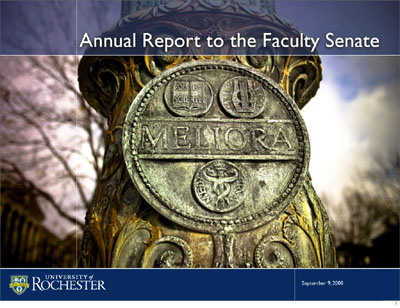
The state of the University is strong and it is growing stronger. I am delighted to report that last year was one of significant progress at the University of Rochester and that our progress is likely to accelerate in the years to come.
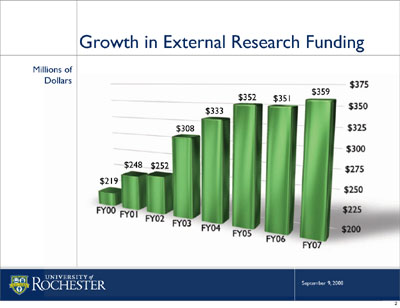
Between 2000 and 2007, University of Rochester external research funding grew from $219 to $359 million to support thousands of active research projects in medicine, optics, engineering, and other high-tech fields.
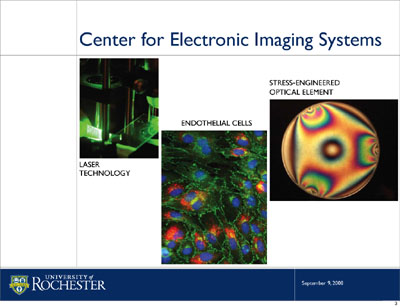
In November 2007, the University’s Center for Electronic Imaging Systems announced a record $120 million economic impact in New York State for such projects as space-faring telescopes, medical devices, digital cameras, and remote sensing technology for military drones.
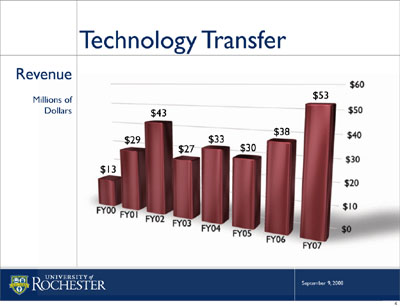
For the past six years, the University of Rochester has been among the top 10 universities in the country in terms of the royalty revenue we receive from our licensed technologies. In 2007 our research generated $53 million. This is all the more impressive because of our relatively small size.
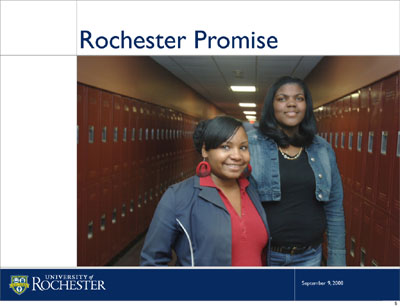
In December 2007, the College of Arts, Sciences and Engineering established the Rochester Promise, a new scholarship program through which initially up to 40 qualified Rochester City School District students will be awarded $25,000 to cover tuition costs for four undergraduate years. The first 11 Rochester Promise students were admitted and have enrolled this fall as first-year students.
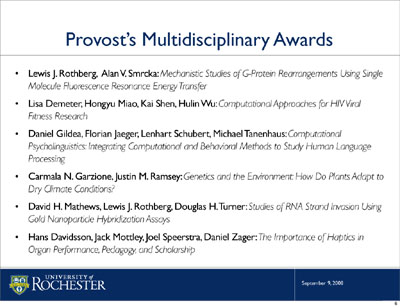
In February 2008, I adopted the report of the Multidisciplinary Advisory Committee to create the Provost’s Multidisciplinary Awards. This program will award up to $250,000 annually to support faculty research that crosses disciplines, whether within one school or across two or more schools. Over 50 applications from faculty in 62 departments in every school were submitted. With assistance from a faculty advisory committee, Provost Ralph Kuncl recently announced the first six research awards for 2008-09.

In March 2008, I adopted the Report of the University Council on Environmental Sustainability, co-chaired by Ralph Kuncl and Dean Peter Lennie. To implement this Report, a new University Council on Sustainability was created, co-chaired by Ralph Kuncl and Chief Financial Officer Ron Paprocki. Among many other exciting new initiatives was our recent agreement with Community Energy and Rochester Gas & Electric to supply sufficient wind-generated electricity to power all residential life buildings on the River Campus.
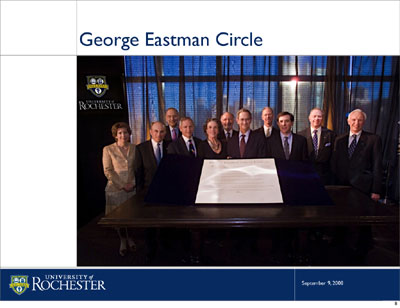
On April 2, 2008 the George Eastman Circle, our new University-wide Annual Fund leadership and recognition society, was publicly launched. Our goal for the Charter phase was 250 members. We now have over 900 George Eastman Circle members, who have made five-year unrestricted Annual Fund pledges, totaling more than $18 million and benefiting every school and major unit of the University.
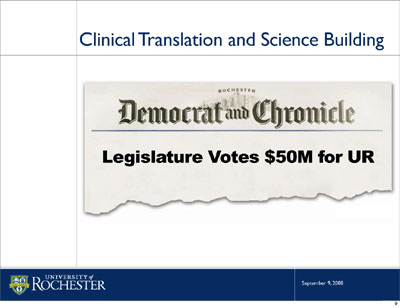
On April 9, 2008, the New York legislature voted $50 million to support the Medical Center’s Clinical and Translational Science Building. This was the consequence of a strong proposal made earlier by the School of Medicine and Dentistry to the National Institutes of Health, which resulted in our receiving an inaugural $40 million Clinical and Translational Science Award in October 2006.
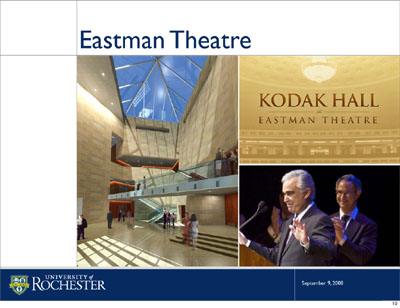
On April 11, 2008, Eastman Kodak Company publicly committed $10 million to the renovation and expansion of Eastman Theatre. This was a particularly meaningful gift considering George Eastman’s seminal role in creating the original theater and the Eastman School of Music.
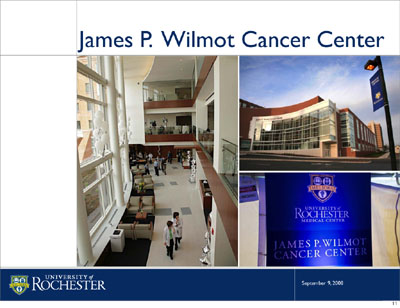
On May 15, 2008, the new James P. Wilmot Cancer Center was dedicated, following the completion of a $42.5 million capital campaign, thanks in part to a series of major gifts announced at the Discovery Ball on May 10, including a $6 million commitment from Excellus and an additional $3 million commitment from the Wilmot family, bringing the Wilmot family’s total support for the new facility to $8 million.
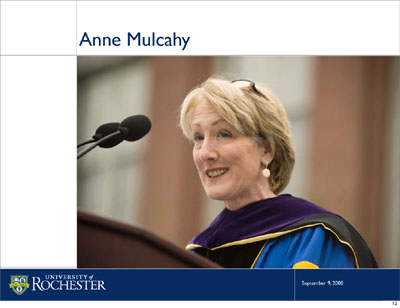
At our College Commencement ceremony last May 18, Xerox Chief Executive Officer and Chair Anne Mulcahy also announced a $1 million gift from Xerox to the Wilmot Cancer Center.
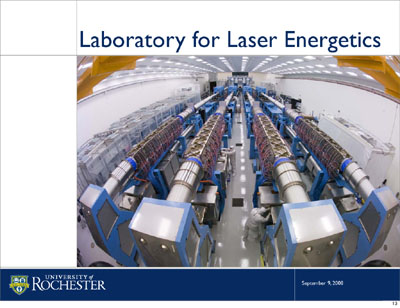
On May 16, 2008, we dedicated the Omega EP laser at the Laboratory for Laser Energetics with Senator Chuck Schumer delivering the keynote remarks. The Omega EP will be the most powerful laser of its type when it becomes operational. Earlier last academic year the Department of Energy renewed its agreement to support the Laser Lab during the next five years with $351 million in potential commitments.

We closed the last academic year with a record performance by our University Advancement team. Two years ago we raised $69.9 million in total cash. The following year total cash support grew by 21.2 percent to a record-breaking $84.7 million. Last year, total cash reached a record level of $109.1 million, the first time University cash receipts exceeded $100 million and a 28.8 percent growth over the prior year. This is a significant expression of confidence by our alumni and friends in the nature and pace of our progress.
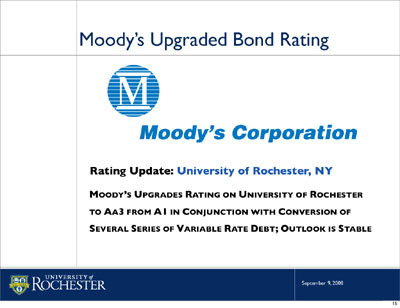
On August 26, 2008, Moody’s Investors Service provided us a third-party validation that we are on the right path by upgrading our bond rating from A1 to Aa3. Moody’s specifically described as among our strengths:
- Large and diversified enrollment base with highly reputable graduate programs and continued strengthening of student demand, most directly demonstrated by a ramp up in yield on admitted students (23.4 percent in 2007 compared to 19 percent in 2005).
- Healthy and highly consistent cash flow generation by the University as a whole, stemming from strong performance of the health system, growing research activities and rising endowment.
- Potential for significant expansion in fundraising success as senior leadership team focuses on investing in development infrastructure.
SENIOR LEADERSHIP
Leadership at our University begins with our Board of Trustees, who have ultimate fiduciary responsibility for our University.
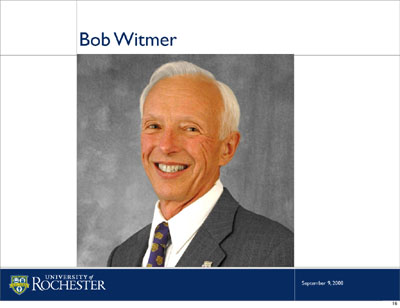
The Board experienced a pivotal transition when Bob Witmer completed five great years as Chair. In Bob’s honor, the Witmer Award for Distinguished Service was created to recognize outstanding career achievements by our staff.
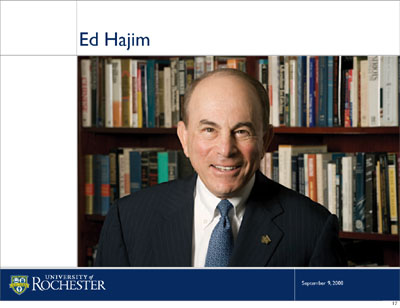
On May 16, 2008, the Board elected Ed Hajim to be the new Chair. Ed, a Class of 1958 engineering graduate, has served our University for nearly 30 years on the Board. He brings remarkable energy, wisdom and vision to his Chairmanship. This past May we also elected four outstanding leaders to our Board:
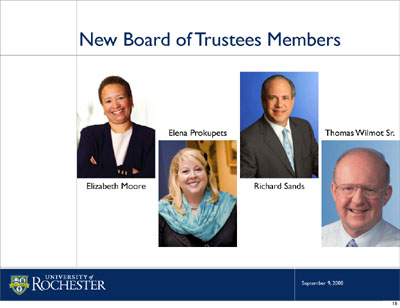
New York City attorney Elizabeth Moore, Lenel Systems International founder Elena Prokupets, Constellation Brands Chair Richard Sands, and Wilmorite President and Chair Thomas Wilmot.
Last year I reported to the Faculty Senate that the direct reports in my senior leadership team were completed when Provost Ralph Kuncl and Dean of the Eastman School of Music Douglas Lowry began their roles here.
This year I am pleased to report that three additional senior leadership appointments were made last year, which complete all positions in the President’s Cabinet.
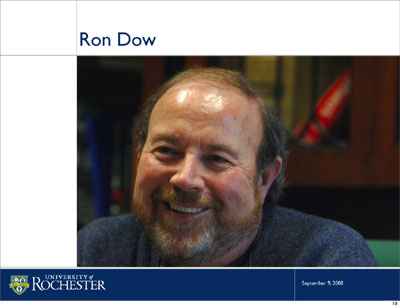
In March Ron Dow, the Dean of our River Campus Libraries, stepped down after 11 years of service.
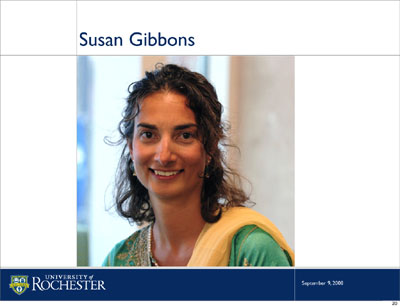
Ralph Kuncl chaired a selection process that led to the appointment of Susan Gibbons as the Andrew H. and Janet Dayton Neilly Dean of River Campus Libraries and Vice Provost. Susan most recently had served the University as Associate Dean for Public Service and Collections Development.
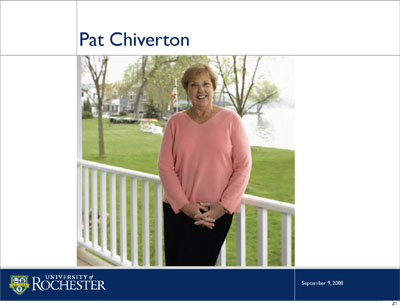
After Pat Chiverton announced that she was retiring from her post as Dean of the School of Nursing, Ralph Kuncl also led a search for Pat’s successor.
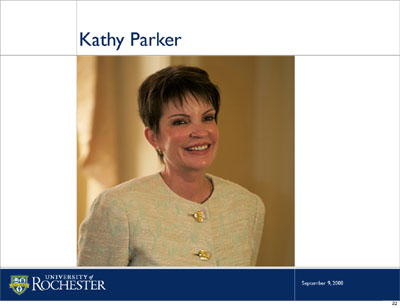
On July 1, 2008, Brad Berk announced the appointment of Kathy Parker as the School’s new Dean. Kathy comes to us from Emory University, where she was a professor in the Department of Family and Community Nursing in the Nell Hodgson Woodruff School of Nursing, a nationally recognized researcher in sleep disorders, an author of over 100 journal articles and a clinician with more than 20 years’ experience.
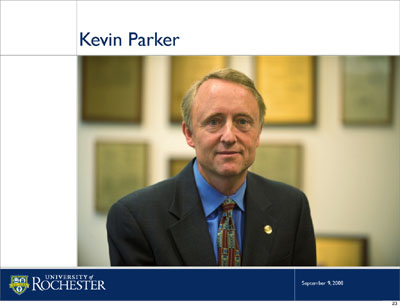
Peter Lennie appointed Duncan Moore to chair the search for a new Dean of the School of Engineering and Applied Sciences after Kevin Parker announced that he would conclude his time as Dean.
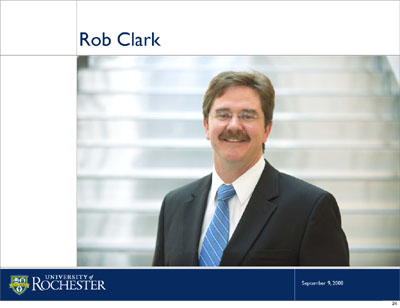
On July 15, 2008, Peter Lennie introduced Rob Clark as the new Dean. Rob served six years as senior associate dean and the past year as Dean at Duke University’s Pratt School of Engineering, where he oversaw implementation of the School’s strategic plan, a doubling in the number of women on the faculty and a tripling in research expenditures. Rob is an expert in the science of acoustics and bionanomanufacturing.
Let me articulate the entire University’s gratitude to Ron Dow, Pat Chiverton and Kevin Parker for their exemplary careers as academic leaders and their outstanding contributions to our University.
STRATEGIC PLANNING
This was a consequential year for strategic planning. At the March 2008 Board of Trustees meeting, we presented strategic plans for each of the academic divisions and several other programs, including campus master planning, advancement, communications, and diversity. I am enormously pleased with our progress. In October, we will present to the Board for its approval final strategic plans for each academic division. Our presentation will summarize strategic objectives for the University and the objectives implicit in the academic division plans; delineate performance measures; provide an updated financial model; and summarize efforts to address key unresolved issues as of the March meeting, including the Certificate of Need for the Medical Center’s Pediatric Replacement and Imaging Sciences Modernization (PRISM) facility, short- and long-term approaches to parking on the River and Medical Center campuses, and IT strategic planning. During the October Board meeting, we will also present the Campus Master Plan for approval. Here a pivotal unresolved issue to be addressed will be a potential exit from Interstate 390 called the Kendrick Interchange, which will facilitate expansion of University facilities, particularly on the Medical Center side of Elmwood Avenue.
After the October Board meeting, the Strategic Planning Advisory Committee and then the full Board will draft a vision statement that will articulate University-wide themes. As I stated last year, the University Vision Statement is likely to emphasize several themes:
- We are proud to be one of the world’s great research universities and look forward to substantially strengthening our ability to provide world class teaching, research, scholarship, and clinical care in the 21st century.
- We intend to be a larger university.
- We are planning to be a university that places greater emphasis on interdisciplinary programs both within our academic divisions and among them.
- We will reaffirm University-wide commitments to academic freedom, diversity, and the Rochester community.
- We will address the topics of alternative energy and sustainability at our University.
Our objective most succinctly is substantially to improve the quality of University teaching, scholarship, clinical care and student experience while reducing our endowment draw to sustainable levels.
MEDICAL CENTER
This was an impressive year for the Medical Center.
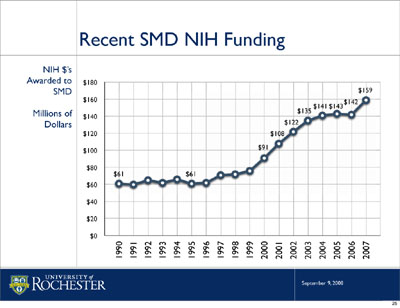
NIH research support to the School of Medicine and Dentistry increased 11 percent (from $142 to $159 million), which was the third highest rate of increase among medical centers nationally and
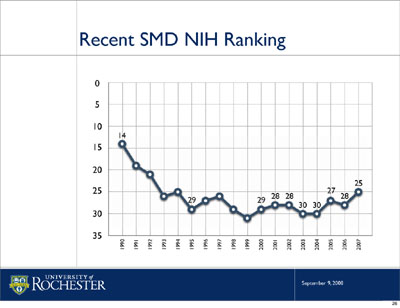
improved the School of Medicine’s NIH rank to 25th. This is a great achievement for Dean David Guzick and a remarkable School. The prioritization of research goals in the Medical Center strategic plan coupled with recent expansions in lab space such as
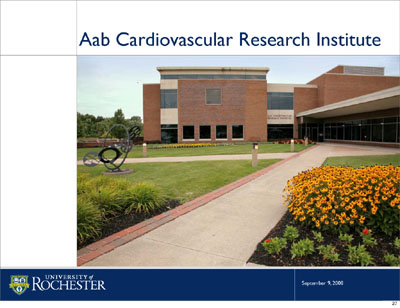
the Aab Cardiovascular Research Institute and future expansions
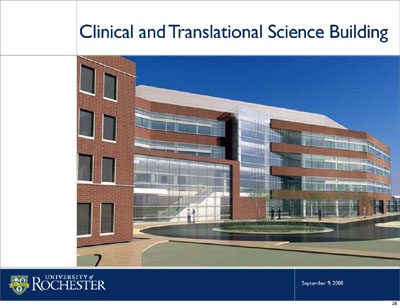
such as the Clinical and Translational Science Building are portents that this progress will continue.
Medical Center Chief Executive Officer Brad Berk has focused on creating a translational research environment in the School of Medicine and Dentistry, the School of Nursing, and the Eastman Dental Center. The proximity of the Clinical and Translational Science Building to the School of Nursing should have a significant impact on further supporting the School’s research funding, which jumped from 28th in 1999 to as high as 12th in 2005.
The Medical Center Strategic Plan has proposed approximately $500 million in expansion plans during the period through 2015, which the Center for Governmental Research estimates will add 1,800 new jobs and $90 million in annual labor income.
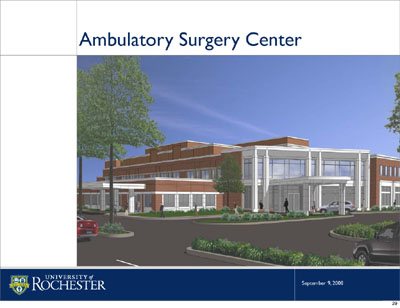
A Certificate of Need was approved for a new Ambulatory Surgery Center on Sawgrass Drive. Ambulatory surgery is an emerging area of Medical Center growth. Construction began in June of this year and will be completed by June 2009.
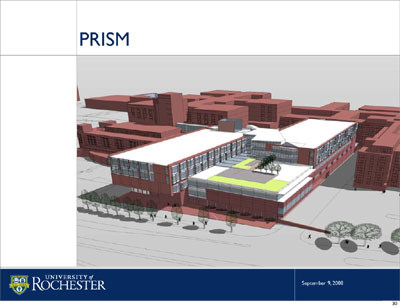
Most significantly, in October 2007 the Medical Center filed a request with the New York State Department of Health for a Certificate of Need for the PRISM project that potentially will add 123 adult beds, increase total beds at Strong from 739 to 862, modernize pediatric care, and substantially expand imaging services. Preliminary cost estimates for this project are approximately $250 million. Regulatory review continues with resolution of the Certificate of Need application at the state level likely to occur in October 2008. A significant step forward occurred in late June 2008 when the 2020 Commission of the Finger Lakes Hospital System Agency announced its unanimous support for the PRISM project.
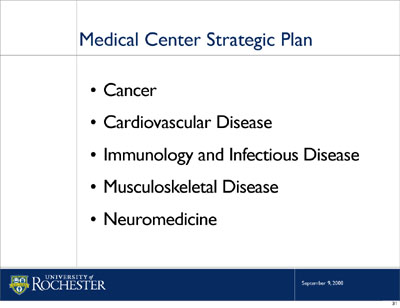
The Medical Center Strategic Plan emphasizes five Integrated Disease Programs:
Cancer
Cardiovascular Disease
Immunology and Infectious Disease
Musculoskeletal Disease
Neuromedicine
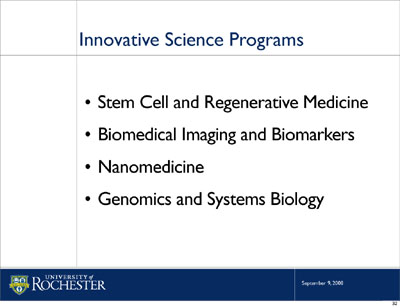
Simultaneously the Medical Center will invest in four Innovative Scientific Programs:
Stem Cell and Regenerative Medicine
Biomedical Imaging and Biomarkers
Nanomedicine
Genomics and Systems Biology
COLLEGE OF ARTS, SCIENCES AND ENGINEERING
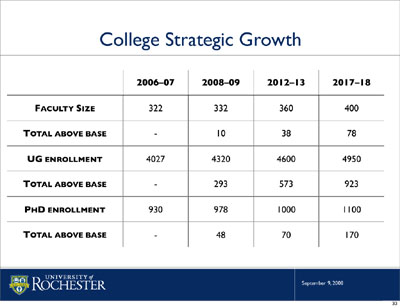
The essence of the College’s Strategic Plan involves an expansion in faculty size from approximately 320 in 2006-07 to approximately 400 over a ten-year period, including 60 new faculty to support planned initiatives and 20 new faculty to strengthen existing departments and programs. Simultaneously the plan proposes that the undergraduate student body will grow from approximately 4,000 to 5,000 students and Ph.D. students will increase from approximately 900 to 1,100.
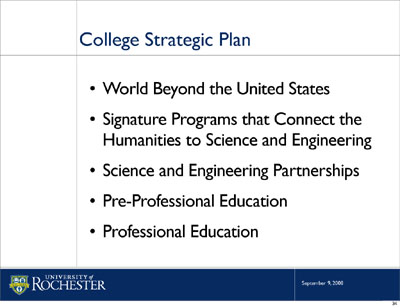
The College Strategic Plan emphasizes priority areas for growth, notably including:
- The World beyond the United States, focusing on areas such as International Relations and Global Studies;
- Signature programs that connect the humanities to science and engineering such as “Music and Sound,” an initiative that combines strengths of the College and the Eastman School;
- Science and engineering partnerships such as Computational and Physical Biology, Genomics, Nanoscience for Medicine and Alternative Energy, which will focus on photovoltaic devices and fuel cells;
- Pre-professional education, particularly in the broadly defined areas of public health and business; and
- Professional education, including a new Post-Baccalaureate Pre-Medical Education program.
The College plan also addresses life outside the curriculum and recommends construction of a Village for the Arts, incorporating a renovated Todd Union and Strong Auditorium, and an expansion of the Goergen Center and other athletic facilities.
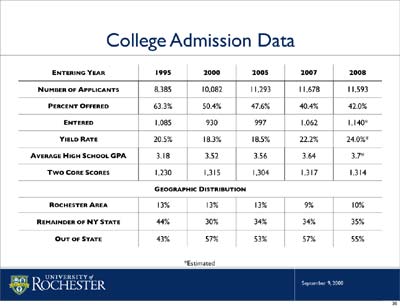
The College Strategic Plan builds on striking recent progress in the number of applicants, matriculation or yield rate, entering grade point average, and SAT scores.
Several steps were taken by the College to implement aspects of its Strategic Plan in 2007-2008.
In March 2008, Dean Peter Lennie announced that the new Post-Baccalaureate Pre-Medical program would begin in summer 2008.
On April 9, the New York State Department of Education formally approved a new major in International Relations, a pivotal step in the College’s global initiatives.
Earlier the College Curriculum Committee and Faculty Council approved a new major in Economics and Business Strategy and the Curriculum Committee approved a Business minor.
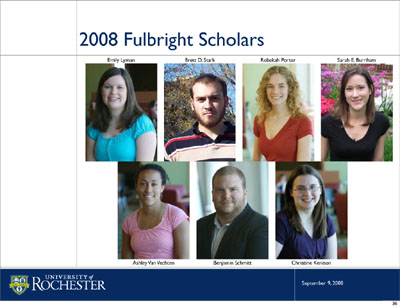
This was a record year for student achievements in the College. Students won a Churchill Scholarship (one of 13 in the nation), a Marshall Scholarship, seven Fulbright Scholarships, and two Goldwater Scholarships. In early August 2008, a UR senior, Brian Palmisano, a senior biochemistry and chemistry major, was named as one of 14 winners in the 2008 National Institutes of Health Undergraduate Scholarship Program.
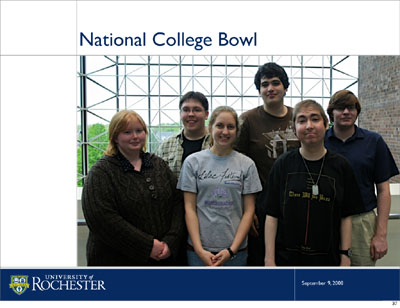
In late April, a five-student team from the University won the National College Bowl Tournament in St. Paul, Minnesota, defeating 15 other regional winners, including Washington University, Ohio State and Rice.
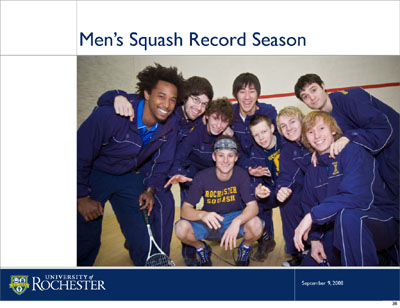
Last year was a thrilling one for Yellowjacket athletics. Ten of our teams were ranked nationally, and several competed in postseason tournaments, including football and women’s soccer in the Eastern College Athletic Conference championships as well as softball, men’s soccer, and both men’s and women’s basketball in NCAA playoffs. The men’s squash team finished their season, with their highest ranking ever, 10th in the country. Five student athletes were named Academic All Americans and eight earned All America honors in their sports. The University can claim the seventh-highest total of Academic All Americans among all 429 active Division III schools.
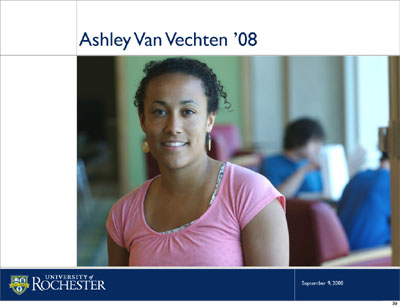
In August of this year, Ashley Van Vechten, Class of ’08, was named a winner of the ECAC Scholar-Athlete Award. Plans are moving ahead to introduce a women’s crew team and a friends-sponsored rowing club for men.
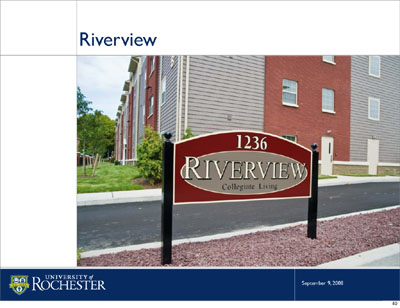
The Riverview Apartments were dedicated on August 7, 2008, and now house close to 400 students just across the Genesee River. This is a major step forward in building a type of college town near our River Campus.
SIMON SCHOOL
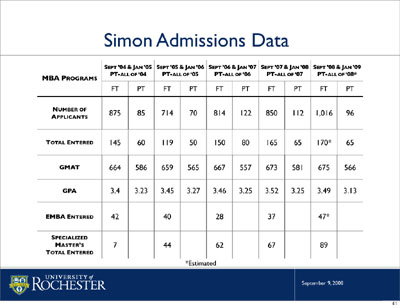
The Simon School of Business continued a substantial turn-around in M.B.A admissions. Under Dean Mark Zupan’s leadership, full-time M.B.A enrollment for the Class of 2009 was 165 students, up from 150 the year before, and 119 the prior year. Simultaneously quality has improved. Since 2003 the average GMAT has increased by 28 points and the average GPA by .29 percent. By comparison, top 50 business schools during the same period have reported an average increase of 5 GMAT points and .02 percent in GPA. One key to this progress has been the success of the Early Leaders initiative, which was responsible for 44 matriculants in the Class of 2009 and received favorable comment in the Wall Street Journal, U.S. News & World Report, Business Week and the Chronicle of Higher Education.
Similar substantial success was achieved in the specialized master’s programs. Five years ago, approximately 10 students enrolled in one-year specialized master’s programs. This past academic year the number increased to 89, with new programs developed with leading schools in Korea and Chile.
In March 2008, the Simon School jumped from 36th to 25th in the U.S. News rankings of graduate business schools.
This progress is consistent with Simon’s strategic objectives, which include:
- Increasing its M.B.A matriculants to 250 full-time students by fiscal year 2013.
- Increasing its specialized master’s students to approximately 150 by fiscal year 2013.
- Increasing its faculty by a net of approximately 10 new faculty concomitant with growth in tuition and fundraising resources.
EASTMAN SCHOOL OF MUSIC

The Eastman School of Music continued to increase the number and quality of student applications, selectivity, and matriculation rates remained consistent with its recent recognitions as this nation’s leading graduate school of music and as the “hottest school of music,” according to Kaplan/Newsweek. Eastman faculty, students and alumni continued this year to capture national and international honors, including Grammy, Emmy and ASCAP awards.
This past year Eastman made substantial progress developing its Strategic Plan, “Empowering the Eastman Advantage,” which envisions, among other new initiatives, substantial facilities enhancements such as the Eastman Theatre renovation and expansion; increased resources for faculty professorships and student tuition assistance; and a Center for Music Innovation to inspire scholarship, teaching and imaginative curricula.
Dean Doug Lowry has played a lead role in the highly effective fundraising campaign for the Eastman Theatre renovation and expansion, announcing a $2.5 million naming gift from the Davenport-Hatch Foundation on April 15, 2008. The project broke ground on July 1, 2008, with nearly $30 million of the approximately $43 million cost raised to date.
WARNER SCHOOL
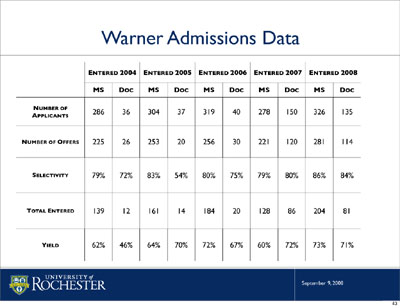
The Warner School of Education similarly has made striking progress. During the past five years, student enrollment has grown markedly, with several programs, including the new Accelerated Ed.D. program and a “pilot” for a new M.S. in Teaching and Curriculum with specialization in Health Professions, playing a consequential role. This type of progress well positions Dean Raffaella Borasi and the Warner School to propose a new building on the River Campus, which will provide sufficient space for the significantly larger student body and faculty. A building proposal will be made to the Board of Trustees Facilities Committee within the next few months and is envisioned to be partially funded by the College, which will take over the space vacated by the Warner School in Dewey Hall and be able to use the new facility during hours when it is not in use by Warner.
ADVANCEMENT AND ENDOWMENT
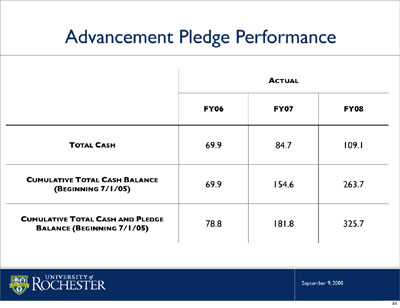
In addition to our record-breaking progress in total cash received, there was also highly significant progress in the growth of our new pledges, which is critical to the long-term success of our fundraising efforts. In FY 08, new pledges set a University record of $64 million. Approximately $21 million of these new pledges have already been received and $43 million of this amount will be received in future years. In all, since the launch of our fundraising efforts on July 1, 2005, we have raised a total of $325.7 million in cash and outstanding pledges.
Substantial progress has been made also in achieving the other goals of Operation Advance. Last year’s highlights include creation of a new donor relations program to begin in the 2008-2009 year at the Medical Center; progress in establishment of National Councils at the College, the School of Medicine and Dentistry, and the Simon, Warner and Eastman schools; hiring ten Regional Directors to begin establishing a strong University presence in 50 states; more than 4,000 face-to-face visits with prospects and donors, doubling the number from the previous year; and continuing progress on implementation of the OASIS IT system with the gift module successfully launched online on July 1, 2008. The final phase of OASIS is on track for completion this coming year.
Our aspiration is clear. We will ultimately complete the largest capital campaign in our University’s history. This campaign likely will be publicly launched during Meliora Weekend in October 2011. I am optimistic that fundraising will continue at record levels as we complete important steps this next year in preparation for going public. The Board of Trustees, working with the National Councils and University academic leaders, will provide a University Vision Statement and later University and Academic Division Campaign Statements will be created. Over the next 18 months, we will conduct a University Leadership Initiative to identify the potential volunteers and benefactors we will need in order to achieve the goals of the campaign. There is much to do before our public launch, but by October 2011 I am now confident that we will have completed the comprehensive steps necessary to launch publicly a successful campaign.
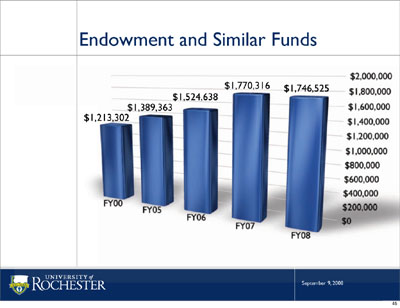
As of June 30, 2008, our long term investment pool, consisting primarily of endowment, was $1.746 billion, which was approximately equal to the value reported last academic year. During the past five years, the University’s investments returned an average of 12.44 percent per year, approximately three percent per annum above the benchmark return. The investment environment last year was challenging. Despite the challenge, the University’s investment return was essentially flat (down one seventh of one percent or 0.13 percent), which compares favorably to the negative 7.45 percent return for our benchmark.
COMMUNICATIONS
We also made substantial progress in communications.
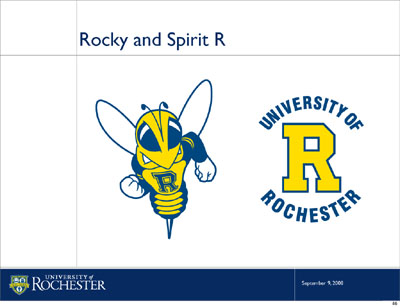
Last September, we launched the new graphic identity, including a new logo and coordinated marks for the Medical Center, Eastman, Simon and Warner. We created also a new spirit R and new Yellowjacket with the name “Rocky” triumphantly announced in February 2008 at the Washington University basketball doubleheader.
We enhanced the Annual Report, Financial Report and University calendar, and created a new fact book.
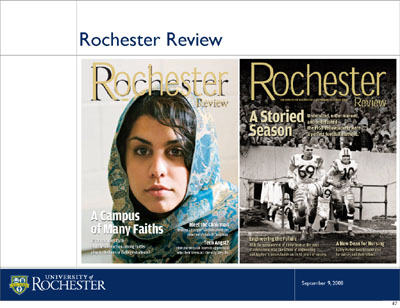
We redesigned Rochester Review and increased its frequency to six issues per year. We also began sending the Review to 7,000 international alumni.
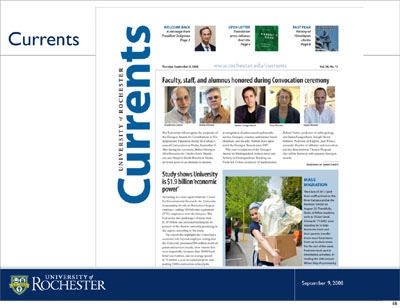
By 2007-2008, @Rochester, the daily e-mail communication to faculty and staff, was sufficiently established with a circulation of 15,000, enabling Currents, with 20 eight-page issues and a circulation of 8,500, to focus on longer and more complex stories.
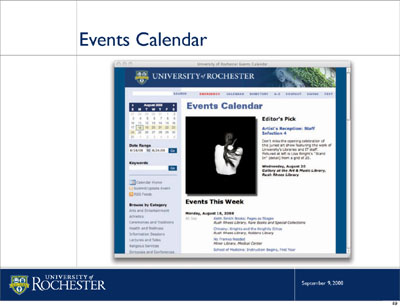
We created a new events calendar that receives an average of 47,000 hits per month (compared to 14,000 for its predecessor).
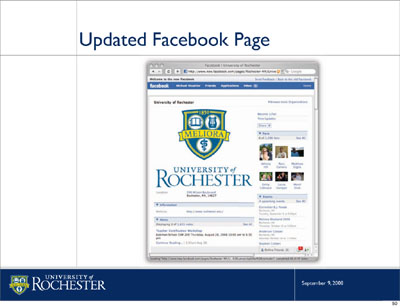
Last year, Communications created a UR Facebook page and YouTube channel, which it plans to enhance in the coming year.
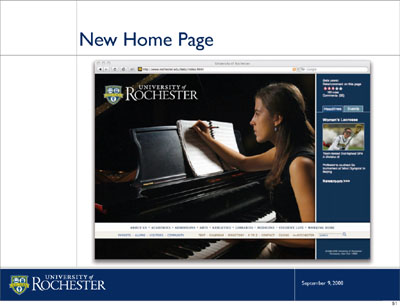
Soon a new home page will make its debut as will a new online Faculty Experts list for journalists.
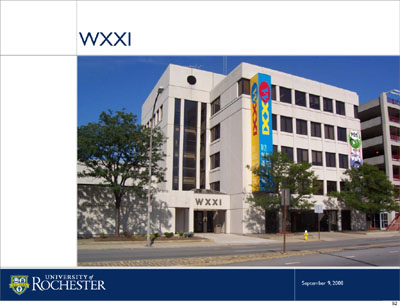
Working with University Information Technology, Communications connected WXXI to the University’s fiber-optic loop, which will permit the University broadcast uplink capability.

Weekly Buzz, a new e-newsletter, is now sent to 5,500 undergraduates in the College and Eastman each Sunday morning. An e-newsletter for graduate students is being planned.
DIVERSITY
Lynne Davidson, Deputy to the President and Vice Provost for Faculty Development and Diversity, is coordinating initiatives to address faculty development and diversity, including those that focus on building applicant pools, a significantly expanded Special Opportunities Fund, efforts to address dual career hires, and further build a welcoming community.
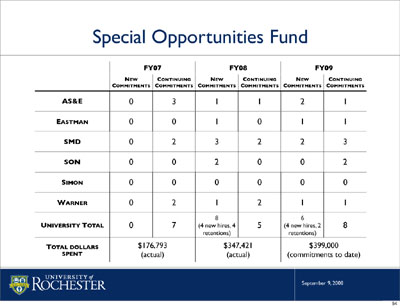
By 2007-2008, all of our schools had a faculty diversity officer in place and several had also created a diversity committee. In 2007-2008, we made some progress in the use of the Special Opportunities Fund, which supported eight commitments last year; strengthened faculty applicant pools through enhanced use of communications, recruitment packages, faculty search committee training and networking techniques; and enhanced faculty development and the creation of a welcoming community through faculty development seminars, mentors, a University-wide diversity forum, the second annual Celebration of Faculty Diversity, with guest speaker Ursula Burns, and in June 2008 publication of responses to Frequently Asked Questions about our diversity initiatives.

Last year in aggregate there was small, but measurable, progress. In September 2006, there were 37 faculty of color in the tenure track ranks or 2.6 percent. By September 2007, this number had increased to 41 or 2.8 percent.
The significance of being an even more inclusive community is highlighted by our international student body. Last year 16 percent of our student body, or 1,495 students, came from outside the United States. This fall, we will have 100 international undergraduates, three times the number that attended the University five years ago. Last year there were 774 international post-docs, researchers, visiting professors and residents. Representatives from 92 different countries joined our University last year.
Our goal is to be a more diverse and inclusive community. We still have far to go. In the Second Annual Report on Diversity in May 2008, I announced that Lynne Davidson, starting July 1, 2008 will work full time on diversity and inclusiveness (rather than half time as in the prior arrangement) and requested that by October 1, 2008, she provide me with recommendations for the 2008-2009 budget that would be consistent with further strengthening the University’s commitment to diversity and inclusiveness.
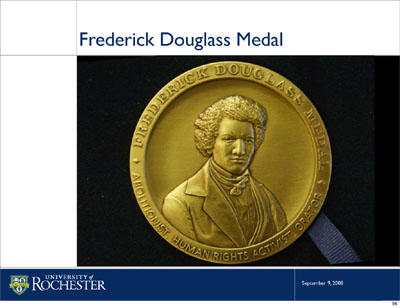
This year the University established the Frederick Douglass Medal to honor individuals, who, through outstanding achievement, represent the ideals for which Douglass stood and who have contributed to the educational life of this University or the community.
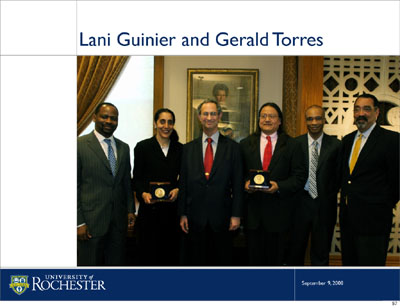
In collaboration with Frederick Douglass Institute Director Jeff Tucker, medals were awarded to Harvard Law School Professor Lani Guinier and University of Texas Law School Professor Gerald Torres following their 2008 Frederick Douglass lectures. On September 23, Frederick Douglass medals for outstanding achievement in civic engagement will be awarded at the inaugural Frederick Douglas Dinner to David Kearns ’52, former Chief Executive Officer of Xerox, and Walter Cooper, Ph.D. ’57, retired Research Scientist at Eastman Kodak and New York State Regent emeritus.
THE UNIVERSITY AND THE COMMUNITY
For the Rochester community, the fundamental objectives remain job creation and economic development. Consistent with our core academic mission, the University is performing significant roles with respect to both objectives.
Our role is particularly meaningful in the greater Rochester community, which between July 2007 and July 2008 lost 3,500 jobs, 2,900 of which were in manufacturing. The University is and will be a leader in the transformation of our economy from one dominated by manufacturing to one that is increasingly characterized by knowledge based institutions.
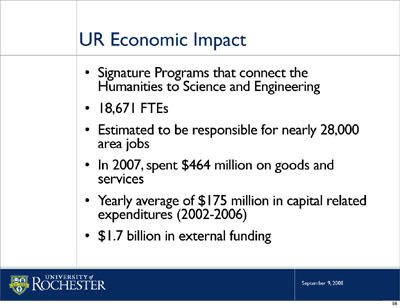
As of year end 2007, employment at the University of Rochester had grown to 18,671 full-time equivalent employees (FTE). Between December 31, 2006, and December 31, 2007, our total FTE count grew by 745 employees. We are now the largest employer in Rochester with approximately double the number of employees of the second largest employer. In August 2008, a report by the Center for Governmental Research on the Economic Impact of the University of Rochester and Its Affiliates, highlighted that there now are over 21,700 full- and part-time employees at the University and conservatively estimated that the University was responsible for approximately 28,000 direct and spillover jobs in the greater Rochester Metropolitan Statistical Area. In 2007, the University and its affiliates purchased goods and services in excess of $464 million and in recent years have spent an average of $175 million for capital improvements. Between the 2003 and 2007 fiscal years, the University received more than $1.7 billion in external funding.
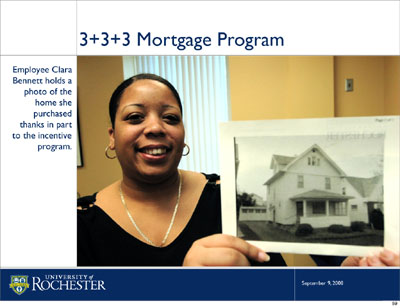
On March 28, the University, working with the City of Rochester and two financial institutions, announced that it would provide $9,000 to each full- or part-time University employee who purchased a home in the neighborhoods immediately contiguous to the University.
CAMPUS MASTER PLAN
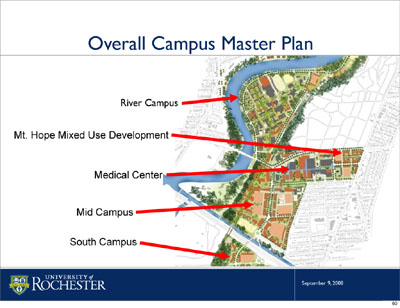
Our Campus Master Plan includes several important facilities projects designed to strengthen our ability to provide outstanding academic, research, clinical, performing arts and student programs.
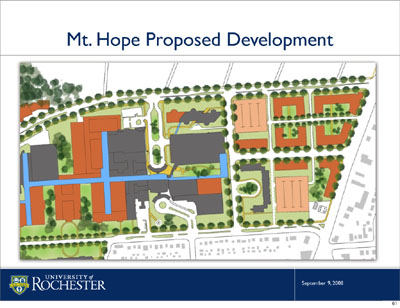
The University, by the end of this calendar year for example, will issue a Request for Proposals (RFP) to develop University property along Mount Hope Avenue between Elmwood and Crittenden. As with our similar project in Brooks Landing, we look forward to partnering with a private developer ultimately to create the most effective combination of retail, office and residential and other uses to best serve our faculty, students, staff and members of the community.
CHALLENGES
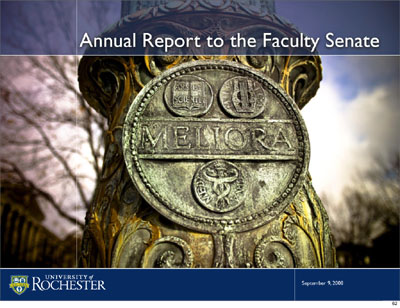
During earlier remarks to the Faculty Senate and the Board of Trustees, I have stressed two fundamental challenges that we face as we move toward implementing our new strategic plan.
The first is the challenge of size. As I explained to the Faculty Senate in October 2006: “The University of Rochester is smaller than virtually all of its peers in both faculty and student size. During the past 15 years, Rochester has been one of the few universities in the country to decrease its student body and has had one of the slowest rates of faculty growth among peer universities.”
Second is the challenge of working with an endowment that is smaller than many peer universities.
I am optimistic that we can address the challenge of size through our strategic plans and that the University’s commitment to building a state of the art advancement team is already beginning to pay substantial dividends that will lead to significant relative and absolute growth in our endowment.
Today, I want to address a new challenge that has developed during our planning period.
Recently there has been significant deterioration in our national economy. Many economists believe that we are or soon may be in a recession. This has implications for us. New York State Governor David Paterson, for example, in August called a Special Session of the State Legislature to attempt “to reduce spending both this year and next year to address plummeting revenues related to a deteriorating economy.” As we move forward with strategic planning, we will watch economic developments carefully. It is already clear that this year it will be unwise to move beyond earlier contemplated budgets or capital projects. In particular, I will carefully monitor capital budgets given the slight decrease in our endowment size. But I want to highlight that now is not the time to retreat from our strategic plans. They are intended to be carried out over approximately a 10 year period. In any 10 year period, there will be years of substantial economic growth and years of deterioration. These tend to average out. In particular, I do not intend to stop faculty searches begun earlier. If the economy were to further deteriorate, ameliorative steps may need to be taken in the future – but we are not there yet, and working with the Board of Trustees, my intent is to pursue a policy of “steady-as-we-go” as we proceed toward adoption of our strategic plans.
CONCLUSION
I remain a perpetual optimist. In the years to come, our momentum will accelerate. Let me emphasize: We are making substantial progress.
As we complete our strategic plans, our emphasis will shift to execution. This is the most exciting part of a strategic plan. What is most inspiring about a galvanizing vision is executing and achieving it. We have succeeded so far in our strategic planning by articulating bold plans. Now we must exercise the discipline to achieve our plans. I look forward to working with each of you this next year and into the future to move the University of Rochester forward. As I often conclude my remarks, “we are just warming up!”
